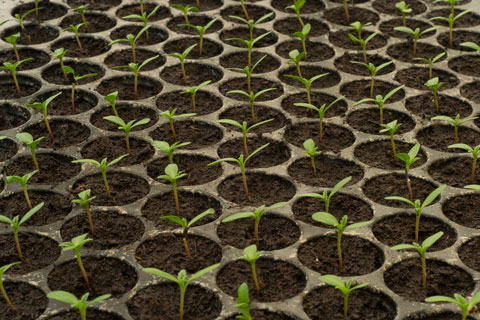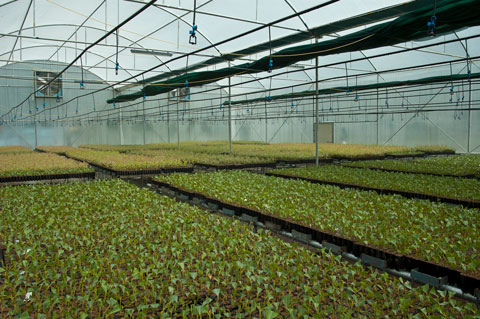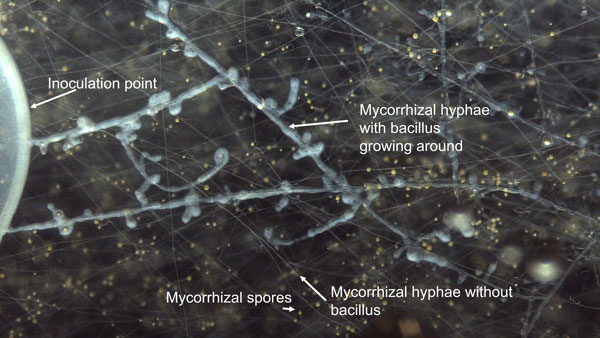11/1/2022
Why a Ready-to-Use Growing Medium?
Dr. Jose Chen-Lopez

Current high prices of horticultural inputs, a labor shortage, environmental constraints and food safety are forcing growers to be creative and more efficient in the way that plants are produced. The production of plugs or cuttings in “ready-to-use” professional growing media covers those four challenges.
The main goal of producing seedlings in trays is to produce healthy transplants with strong root systems, uniform plant height and similar growth stage. This is so they can be transplanted into larger containers to continue with the vegetative stage or transplanted outdoors to produce quality crops earlier in the season to maximize profit and the use of resources. Therefore, it’s very important to use a consistent and uniform germination substrate to fulfill all of these characteristics.
 We must see the root zone as the second half of the plant—let’s give the roots the best home.
We must see the root zone as the second half of the plant—let’s give the roots the best home.
Figure 1. Seedlings in a 98-cell tray. The cell volume is less than 2 in.3, and the growing medium is responsible for anchorage and support for the plants, to act as a water reservoir and nutrient holding/exchange site, and for gas exchange.
Characteristics of a good growing medium
The functions of a growing medium substrate are: to provide anchorage and support for plants, serve as a water reservoir and nutrient holding/exchange site and for gas exchange. I would like to add another—support the rhizosphere microbiome for healthy plant growth and development.
This is important because beneficial microorganisms—besides acting as biostimulants, biocontrol or biofertilizers—can also trigger the Induced Systemic Resistant (ISR) of the plant to prime it against pests and diseases even in distal parts of the plant. In organic crop production, microorganisms are more important since the nutrients need to be converted from organic into ionic form for plant uptake. This process requires more oxygen in the root system because roots and microorganisms deplete oxygen content faster compared to a conventional crop.
When producing transplants, it’s very important to use the right growing medium because developing root systems grow in a finite volume of substrate (Figure 1), depending on the cell dimensions and shape. Roots need to grow freely and cover the entire volume of substrate to promote root anchorage and plant support. At harvest, when lifting the seedling, the rootball must be intact to minimize mechanical stress and to facilitate easier handling during the transplant process.
The substrate serving as a water reservoir is influenced by its physical properties. For transplant production, a professional germination growing medium is designed to hold enough water between watering events in a small volume cell. This can be achieved by manipulating particle/fiber size; small size particles hold more water due to capillarity (adhesive and cohesive water properties). It’s preferable to have a smooth change in particle size because the water retention will change in the same manner as water is depleted from the cell. A single pore size substrate will lose all the water at a certain negative pressure, which gives little leverage when dealing with watering scheduling.
 Figure 2. For plant propagation, unrooted cuttings require high relative humidity and adequate moisture content of the growing medium to avoid drying out and to encourage root development. Note the misting system.
Figure 2. For plant propagation, unrooted cuttings require high relative humidity and adequate moisture content of the growing medium to avoid drying out and to encourage root development. Note the misting system.
The water reservoir is also influenced by compaction. This action causes the closure of macropores (good for drainage and aeration), leaving a greater proportion of micropores (good for holding water), resulting in higher water-holding capacity.
Plant water uptake is achieved by differential pressure between the air, plant and substrate matric potential. Plants spend energy to absorb water; in a substrate with a good ratio of water and air, the plant will spend little energy (Figure 2). However, as the plant depletes water in a cell tray, it spends more energy for water uptake. This effect happens because as the substrate dries, water is more attached to the substrate’s particles.
The pH of the substrate affects the nutrient availability. During the crop cycle, the pH of the growing medium is influenced by the ingredients of the growing medium, water alkalinity, type of fertilizer applied and even plant species. Electrical Conductivity (EC) must be as low as possible to allow the flexibility to work with fertilizers and water quality in a wider range.
Roots need oxygen for respiration and it’s supplied by watering plants. During every watering event, it’s necessary to exchange old air (mostly CO2 due to root respiration) for fresh air (rich in O2). This process can be achieved by making sure to design the irrigation system (especially water flow) with the substrate hydraulic properties to water the entire volume of the substrate and to have drainage to help air exchange and to leach salts. Roots under low oxygen concentration have difficulties absorbing water and nutrients, and they’re more susceptible to diseases. Roots won’t grow in dry parts of the substrate, in saturated substrates or in a substrate with high CO2 concentration. For this reason, it’s very important to have a substrate with good water-air ratio and water-holding capacity after a watering event.
It’s well known that sphagnum peat moss has high water-holding capacity while maintaining good aeration, low salt content, high CEC, low bulk density, is free of weeds and pathogens, and free of phytotoxic substances. By nature, sphagnum peat moss contains beneficial microorganisms (bacteria, fungi and actinomyces), which help to establish a healthy rhizosphere microbiome to produce good-quality plants.
 Figure 3. Plants provide carbon to Glomus intraradices and Bacillus pumilus, while the first microorganism helps with water and nutrient uptake, and the second protects the roots against certain root rot diseases and stimulates the root system.
Figure 3. Plants provide carbon to Glomus intraradices and Bacillus pumilus, while the first microorganism helps with water and nutrient uptake, and the second protects the roots against certain root rot diseases and stimulates the root system.
Nevertheless, the amount of these organisms is low and it’s necessary to add more beneficial microorganisms to take advantage of their benefits like biostimulation, biocontrol, biofertilization or a combination of them. Substrates from organic sources are better suited to support beneficial microorganisms than substrates from mineral sources.
After extensive research to determine the benefits of microorganisms for biocontrol, biostimulation and biofertilization, it was found that Bacillus pumilus and Glomus intraradices are excellent helpers for plants. These organisms form an association with plants called tripartite (Figure 3) in which the plant feeds these microorganisms with sugars and the microorganisms in return help the plant. In this relationship, the plant is most benefited. The bacterium Bacillus pumilus acts as a biostimulant to stimulate root growth and it also protects against certain root rot diseases.
Glomus intraradices endomycorrhizae attaches to and extends the plant root system to bring water and nutrients to the plant in greater volume within the substrate. Since the bacterium also colonizes the mycorrhizal hyphae, the biocontrol is extended wherever the hyphae go. Recently, it was found that both microorganisms indirectly suppress fungus gnats and thrips. Moreover, as mentioned before, both microorganisms are capable to trigger ISR.
Currently, there are growing media available with both microorganisms. Early exposure and colonization of Bacillus pumilus and/or Glomus intraradices of the new roots of a germinated seed will prevent diseases. Plants benefiting from both microorganisms will spend their energy in growing rather than defending themselves against pathogens.
Some features and benefits of professional germination growing media include:
• It’s disease, pest and weed free
• The origin can be organic, mineral or a combination
• There are several options in terms of physical, chemical and biological properties
• It’s free of toxic elements for plants, animals and humans
• Reliable quality control during production
• Consistent and available product year-round
• Predictable performance
• Adequate and balanced initial nutrient content and pH adjusted
• Lightweight and easy to handle
• High plant density, which results in efficient use of resources
• Can be used in automated seeding and transplant processes
• Can better control water and nutrients
• Close to 100% germination rate
• After germination, roots can benefit from biostimulants, biocontrols and/or biofertilizer agents
• More crop cycles in a year—a seedling can be transplanted after a plant is harvested
• Seedlings can be produced under cover, so you’re less dependent on an outside environment
• More plant uniformity and better quality
• Plant growth can be easily manipulated
• Labor saving
• High ROI
• Environmentally friendly—a low CO2 footprint from production to disposal after harvest
• Good technical support GT
Dr. Jose Chen-Lopez is a Horticulture Specialist for Premier Tech Growers and Consumers.